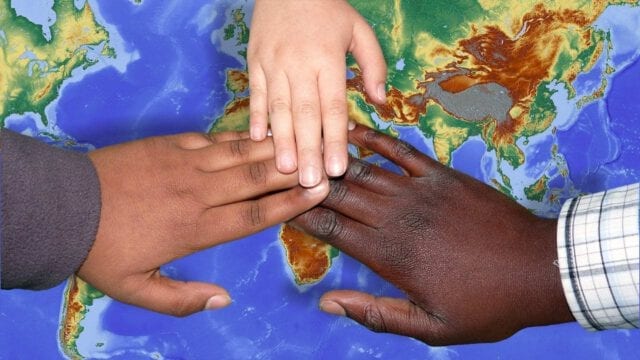Historic and record-breaking contribution Norway on development favor i help humanitarian. An important contribution to international cooperation in the fight against COVID-19
In 2020, Norwegian aid reached a record high of NOK 39,5 billion, representing 1,11% of gross national income.
– The percentage target is important a way to motivate more countries to be more active in development aid, and it is important to ensure long-term that we achieve the goals that we have set ourselves. As we are in a pandemic, Norway's contribution is more important than ever, says Minister Dag-Inge Ulstein.
Sixteen of the thirty DAC members increased their aid in 2020
Norway's historic contribution was presented when preliminary figures for the official development cooperation (ODA) for 2020 have been published by the Organization for Economic Co-operation and Development (OECD). The OECD Development Committee (DAC) is responsible for the presentation. Sixteen of the thirty DAC members increased their aid in 2020 compared to 2019. Norway is listed by the OECD as one of the countries with the highest growth.
We're not safe until everyone is
– We have learned one thing during this crisis; We are not safe until everyone is safe. And although the corona pandemic affects us all, it does not affect everyone equally. Once again, it is the poorest and most vulnerable who suffer the most. The fact that we have increased development aid in this year, which was a year of crisis, is about how make the greatest contribution to life people who have been hit by several other crises in addition to the pandemic, Ulstein says.
Humanitarian aid in 2020 went mainly to the United Nations, the Red Cross movement and Norwegian humanitarian organizations
Adjusted for inflation and exchange rate fluctuations, Norwegian aid rose 8,4%. in the years 2019-2020. This increase is explained, among others, by increased healthcare assistance. Other countries that recorded growth in 2020 are Hungary (+35,8%), Sweden (+17,1%), Slovakia (+16,3%), Germany (+13,7%), France (+ 10,9%), Switzerland (+ 8,8%). Finland (+ 8,1 percent), Iceland (+ 7,8 percent) and Canada (+ 7,7 percent. 2020 humanitarian aid of NOK 5,5 billion went mainly to the United Nations, the Red Cross movement and Norwegian organizations Syria and neighboring countries, Yemen and South Sudan were among the countries that received the largest humanitarian aid in Norway last year.
In our humanitarian operations, we prioritize, among other things, the protection of civilians
- It is common for countries that receive a lot of humanitarian aid from Norway that humanitarian needs are large and growing. The situation has only been made directly or indirectly more difficult due to the Covid-19 pandemic. In our humanitarian operations, we prioritize, inter alia, the protection of civilians and counteracting widespread food insecurity. In many crisis situations, working conditions are currently very demanding for humanitarian actors. Therefore, the Norwegian humanitarian effort was more important than ever, not least because we were able to show great flexibility as donors, says Foreign Minister Ine Eriksen Søreide.
Developing countries, especially the poorest ones, were less prepared to deal with the negative consequences of the pandemic
Norway is one of the few donor countries to meet the UN target of 0,7% of Gross National Income for official aid. In 2020, six DAC countries achieved this goal, including Norway. The other countries are Denmark, Luxembourg, Great Britain, Sweden and Germany.
“When the pandemic hit us, rich countries like Norway created crisis packages for the business environment and spent large sums of money on helping people and institutions to cope with the consequences of the economic downturn. Developing countries, especially the poorest countries, were less prepared to deal with the negative consequences of the pandemic. They have been affected by restrictions on trade and tourism, restrictions on transfers of workers abroad, and capital flight to rich countries. The consequences are now visible, says Ulstein.
Norway was actively working to be able to donate more resources to international cooperation against COVID-19
An important explanation for increased development aid Norway is its contribution to international cooperation in the fight against COVID-19. Much of the collaborative international effort against COVID-19 and the consequences of the pandemic in developing countries is being directed through multilateral organizations.
- Norway was actively working to be able to donate more resources to international cooperation against COVID-19. Through our contribution to the World Health Organization (WHO), the Gavi and Cepi vaccine alliance, we support the development and distribution of vaccines against COVID-19, in addition to other essential vaccines. For over twenty years, global health has been at the heart of Norwegian development policy. It is in everyone's interest to ensure that testing equipment, drugs, and vaccines are available to everyone. And then the healthcare system has to work as well, says Ulstein.
The closure of societies during a pandemic reduces the income opportunities of poor countries
-Norway help is useful. The closure of societies during a pandemic also reduces the income opportunities of poor countries. At the same time as incomes decline, there is a growing need for health resources, education and food on the table for the weakest, says Ulstein.


